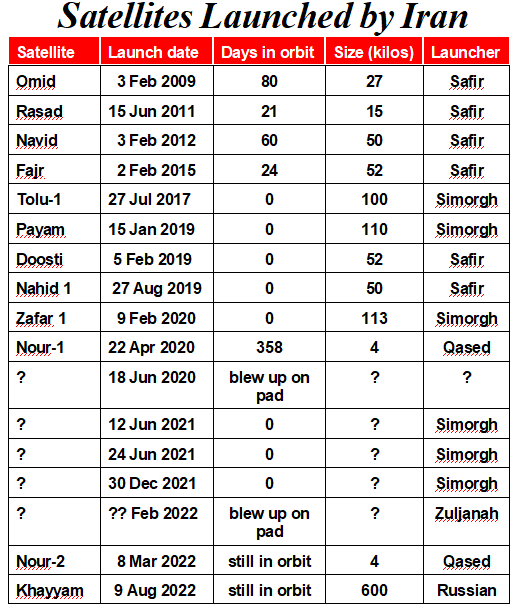September 23, 2022

Russia has successfully launched a space satellite for Iran, underscoring how unsuccessful Iran’s own space program has been after 17 years of trying to go it alone without Russia’s help.
Iran said the satellite, dubbed Khayyam after poet and mathematician Omar Khayyam, was made by Iran. But the evidence available indicates it is more likely a Russian-designed and Russian-built satellite with a Persian name.
Many western media outlets sought to link the August 9 satellite launch to the visit to Iran several weeks earlier of Russian President Vladimir Putin. But satellite preparations take much more than several weeks. Furthermore, Iran signed an agreement with Russia in 2015 for it to build and launch satellites for Iran. Nothing happened for years and at one point an Iranian official said the two counties were still negotiating over what Russia wanted to charge Iran, suggesting Tehran thought Moscow was trying to bilk it.

But the day after the launch, Hassan Salarieh, head of the Iranian Space Agency, told reporters the satellite was built by a Russian company “based on parameters determined by Iran and also under the Islamic Republic’s supervision.” In other words, he was saying Khayyam was designed by Iran and built by Russia. But the satellite talks going back to 2015 were based on Iran buying a Kanopus-V Russian satellite.
A few days after that, Telecommunications Minister Issa Zarepur said the macro and conceptual designs of the satellite were developed by Iran’s Space Agency, while the satellite was built in Russia. The term “macro and conceptual designs” sounds like a set of goals Iran asked Russia to fulfill. Zarepur also said the important thing about the construction of Khayyam was that Russia agreed to transfer technology to Iran, suggesting that Iran had not any real role in crafting Khayyam. Government spokesman Ali Bahadori-Jahromi later said Iran plans to build three more Khayyam satellites itself.
Russian mentions of the sale to Iran ended in May 2018 after the US sanctioned several companies previously named as involved in building the satellite for Iran. But according to a website, The Space Review, an official of one of those firms, NPK Barl, told Russia’s parliament last summer that Russia would launch a Russian-designed and -manufactured satellite for a “foreign customer” this summer. The firm has not mentioned talks with any foreign country except Iran.
With the orbiting of Khayyam, Iran owns three satellites currently orbiting the earth. Iran’s satellite program began when Russia launched a Russian-built satellite paid for by Iran on October 27, 2005. Named Sina, that satellite is still orbiting the earth after almost 17 years. But it isn’t known if it is working. Iran has not even mentioned it in more than a dozen years.
The second satellite is Noor-2, a military satellite Iran launched March 8, which is still orbiting the earth. Iran has released two photos it says it received from the satellite. The Pasdaran launched Noor-1 April 21, 2021, and continues to boast of it. However, US officials said it was not properly orbited and was tumbling head-over-heels, meaning it was useless for taking photos. Noor-1 fell out of orbit April 14 this year, meaning it set an Iranian record in orbit of 358 days. No other Iranian-launched satellite survived even 100 days in orbit. And only four ever reached orbit.
Khayyam is operated by Iran’s civilian space agency, which said Khayyam has no military applications. Many around the world doubted that. However, Iran claimed a resolution for Khayyam’s cameras of 1.2 meters, meaning one pixel covers a spot 1.2 meters across. But Iran can buy and does buy satellite photos in Europe with resolutions three times better for just $10,000 each, according to Maj. Gen. Yitzhak Ben Israel, the former head of Israel’s space program.. So, it isn’t clear that Khayyam can be of much use militarily.
Iran has reported resolutions on the satellites it successfully orbited earlier at between 5 and 10 meters, so Khayyam is definitely an improvement.
Iran’s description of Khayyam says it will be used for such tasks as monitoring agriculture, borders, water resources, fires and the like. And Iran can certainly use help monitoring water resources.
According to the Global Center for Adaptation in the Netherlands, the bird’s eye images captured from satellites can offer greater insight into factors like crop performance and fertilizer use than on-the-ground observations.
Khayyam weighs in at more than 600 kilograms, 12 times as big as any Iranian satellite yet orbited by Iran and much too heavy to be lofted by any Iranian rocket. The satellite, circling about 500 kilometers above the earth, crosses any spot on earth four times a day, allowing photos to be taken of any spot every six hours.
To some, it appeared that Iran’s authorities had largely given up on Iran being able to orbit useful satellites and decided to go with a Russian satellite rather than see more years whiz by without Iran gaining from what satellites can offer.
